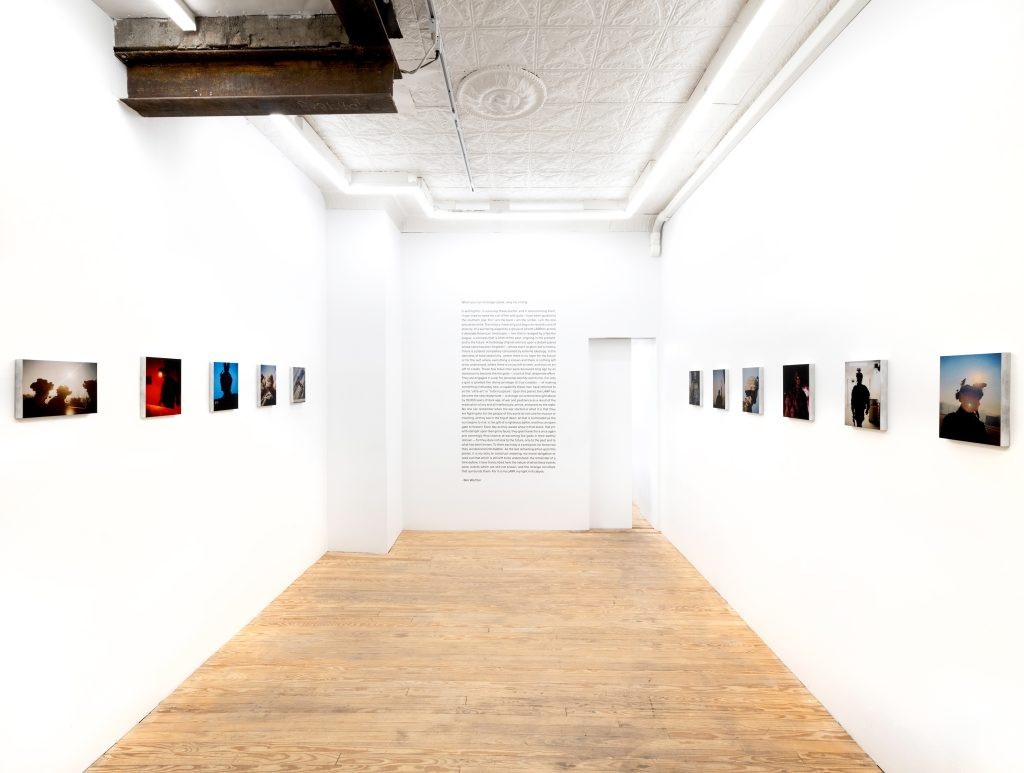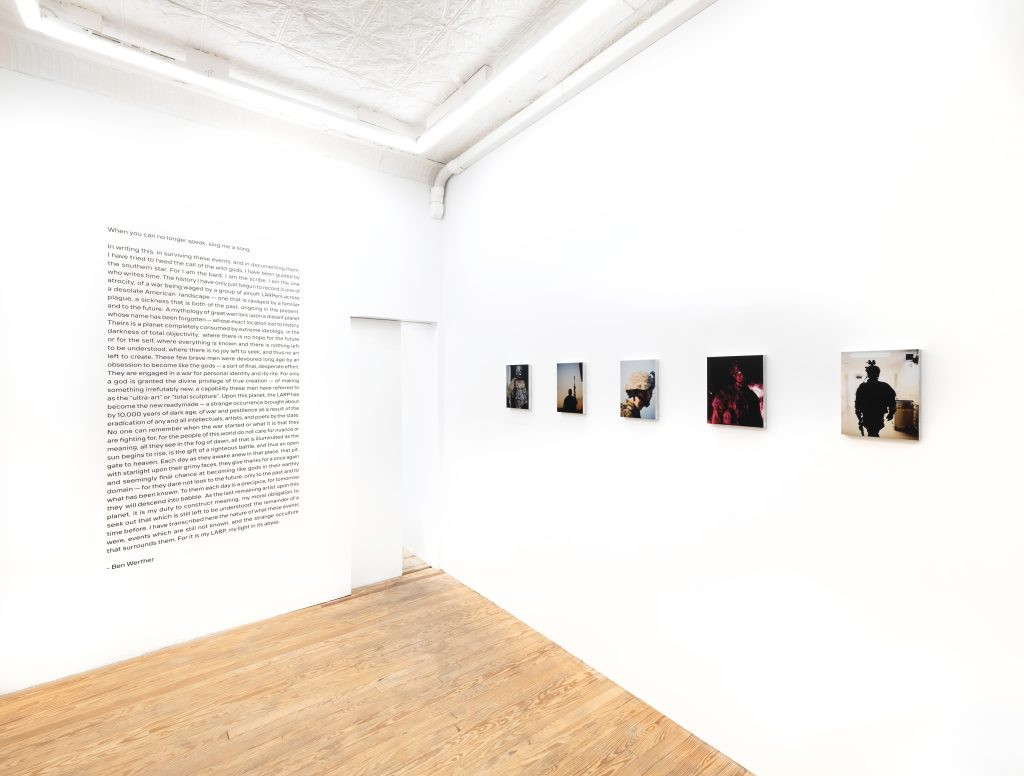Ben Werther’s exhibition, When You Can No Longer Speak, Sing Me a Song, recently hosted at No Gallery in New York City, presents a compelling exploration of contemporary identity and simulated conflict. Running from May 30th to July 7th, 2024, this exhibition delves into the subculture of MilSim (Military Simulation) through Werther’s lens, inviting viewers to consider the profound questions embedded within this seemingly niche world. Werther’s work prompts us to consider: when words fail, what songs do we sing, and what realities do we construct for ourselves?
 Installation view of Ben Werther's exhibition, showcasing dye sublimation prints on aluminum, exploring themes of simulated military operations and identity.
Installation view of Ben Werther's exhibition, showcasing dye sublimation prints on aluminum, exploring themes of simulated military operations and identity.
The exhibition’s title itself, When You Can No Longer Speak, Sing Me a Song, suggests a shift from verbal communication to a more primal, perhaps artistic, form of expression. In the context of Werther’s photography, this “song” becomes the visual narrative he crafts around MilSim. The exhibition isn’t simply a documentary of airsoft enthusiasts; it’s a deeper inquiry into the human psyche, our fascination with conflict, and the construction of self in a simulated world.
MilSim as a Stage: Performance and Identity
Werther doesn’t merely document MilSim; he immerses himself within it. His photographs capture participants engaged in elaborate simulations, using airsoft replicas in meticulously staged environments. These aren’t real soldiers in combat, but players enacting a carefully constructed drama. This distinction is crucial. MilSim, as Werther portrays it, is a form of LARP (Live Action Role Play) stripped of historical context, driven purely by the participants’ fantasies and media-influenced perceptions of conflict.
 Exhibition space featuring multiple photographs from "When You Can No Longer Speak, Sing Me a Song", highlighting the immersive and theatrical nature of MilSim events.
Exhibition space featuring multiple photographs from "When You Can No Longer Speak, Sing Me a Song", highlighting the immersive and theatrical nature of MilSim events.
The “battlefields” of MilSim are bloodless. The weaponry, while visually accurate, fires only plastic BBs. Yet, the intensity of the experience is palpable in Werther’s images. Participants, clad in military fatigues, navigate imagined scenarios, revealing a complex interplay of performance and genuine engagement. This performance raises questions about identity. Are these individuals simply playing roles, or are they exploring deeper facets of themselves through these simulations? The lack of tangible stakes in MilSim allows for a unique form of self-expression, a “singing” of identity unbound by the constraints of everyday life.
The Allure of Simulated Violence: Beyond Ethics
The exhibition text astutely points out the potential discomfort around military fetishism. However, Werther’s work transcends a simple endorsement or critique. He uses the visual language of documentary photography – lens flares, motion blur, pixelation – to blur the lines between reality and fantasy. This technique mirrors the experience of video games like Call of Duty, creating a sense of first-person perspective that draws the viewer into the simulated world.
 Close-up of a photograph from the exhibition, emphasizing the use of visual techniques like lens flare and motion blur to create an immersive, video game-like aesthetic in Werther's portrayal of MilSim.
Close-up of a photograph from the exhibition, emphasizing the use of visual techniques like lens flare and motion blur to create an immersive, video game-like aesthetic in Werther's portrayal of MilSim.
Werther isn’t interested in the ethical debate surrounding MilSim. Instead, he delves into the “deeper, darker, and ultimately more interesting” aspects of this subculture. He presents MilSim as a space where anxieties and obsessions are played out, a stage for exploring the human fascination with power, control, and conflict, without real-world consequences. This is where the “song” becomes particularly poignant – a song of desires, fears, and fantasies expressed through action and imagery, rather than explicit words.
Cosmic Horror and the Unknowable
The review positions MilSim through the lens of cosmic horror, drawing parallels to Thomas Ligotti’s unsettling narratives. This framework is insightful. There’s an undefinable, almost menacing system at play within MilSim, a “Hydra” of meanings and interpretations. Is it political? Apolitical? Purely a hobby? Werther doesn’t offer easy answers. He embraces the ambiguity, the “realm of unknowing,” much like the mystic text “The Cloud of Unknowing” suggests.
 Artwork titled "The soft black stars" by Ben Werther, a dye sublimation print on aluminum, suggesting the cosmic horror undertones in his exploration of MilSim culture.
Artwork titled "The soft black stars" by Ben Werther, a dye sublimation print on aluminum, suggesting the cosmic horror undertones in his exploration of MilSim culture.
The “soft black stars,” a title of one of Werther’s works featured in the exhibition, evokes this sense of cosmic dread and unseen forces. MilSim, in this interpretation, becomes a microcosm of larger, more ineffable human drives and anxieties. The inability to articulate these complexities directly – when you can no longer speak – leads to the “song” of action, simulation, and artistic representation.
Conclusion: Listening to the Song of Simulation
When You Can No Longer Speak, Sing Me a Song is more than just a photography exhibition; it’s an invitation to contemplate the multifaceted nature of human expression and the simulated realities we inhabit. Ben Werther’s work at No Gallery encourages us to look beyond the surface of MilSim culture and listen to the deeper “song” it sings – a song of identity, fantasy, and the enduring human need to create meaning, even in the absence of words. For those seeking art that provokes thought and challenges perceptions, Werther’s exhibition offers a powerful and resonant experience.

